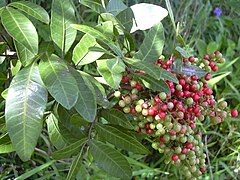Schinus terebinthifolius
| Schinus terebinthifolius subsp. var. | Brazilian pepper tree | |||||||||||||||||||||||||||||||||||||||||||||||||||||||
|---|---|---|---|---|---|---|---|---|---|---|---|---|---|---|---|---|---|---|---|---|---|---|---|---|---|---|---|---|---|---|---|---|---|---|---|---|---|---|---|---|---|---|---|---|---|---|---|---|---|---|---|---|---|---|---|---|

|
|
| ||||||||||||||||||||||||||||||||||||||||||||||||||||||
| ||||||||||||||||||||||||||||||||||||||||||||||||||||||||
Schinus terebinthifolius is a species of flowering plant in the cashew family, Anacardiaceae, that is native to subtropical and tropical South America (southeastern Brazil, northern Argentina and Paraguay). Common names include Brazilian Pepper, Aroeira, Florida Holly, Rose Pepper, and Christmasberry.[1]
Brazilian Pepper is a sprawling shrub or small tree, reaching a height of 7-10 m. The branches can be upright, reclining, or nearly vine-like, all on the same plant. Its plastic morphology allows it to thrive in all kinds of ecosystems: from dunes to swamps, where it grows as a quasi-aquatic plant[2]. The leaves are alternate, 10-22 cm long, pinnately compound with (3-) 5-15 leaflets; the leaflets are roughly oval (lanceolate to elliptical), 3-6 cm long and 2-3.5 cm broad, and have finely toothed margins, an acute to rounded apex and yellowish veins. The leaf rachis between the leaflets is usually (but not invariably) slightly winged. The plant is dioeceous, with small white flowers borne profusely in axillary clusters. The fruit is a small red spherical drupe 4-5 mm diameter, carried in dense clusters of hundreds of berries.
Brazilian pepper is widely grown as an ornamental plant in frost-free regions of South America for its foliage and fruit. It is considered as a melliferous flower.[3]
Although it is not a true pepper (Piper), its dried drupes are often sold as pink peppercorns. The seeds can be used as a spice, if used in moderation, adding a pepper-like taste to food.
Planted originally as an ornamental outside of its native range, Brazilian pepper has become widespread and is considered an invasive species in many subtropical regions with moderate to high rainfall. Brazilian Pepper is hard to control because it produces basal shoots if the trunk is cut. Trees also produce abundant seeds that are dispersed by birds and ants.
| Standard Cyclopedia of Horticulture |
|---|
|
Schinus terebinthifolius, Raddi, with racemose fls., lvs. composed of 7 broader, somewhat serrated lfts. and scarlet berries, is sparingly met with in cult. in S. Calif., and proves hardy in San Francisco. Brazil. CH
|
Cultivation
Propagation
Pests and diseases
Varieties
There are two varieties:
- Schinus terebinthifolius var. acutifolius. Leaves to 22 cm, with 7-15 leaflets; fruit pink.
- Schinus terebinthifolius var. terebinthifolius. Leaves to 17 cm, with 5-13 leaflets; fruit red.
Gallery
- Brazilian pepper tree.jpg
References
- ↑ Schinus terebinthifolius at Instituto de Pesquisas e Estudos Florestais
- ↑ Paulo Backes & Bruno Irgang, Mata Atlântica: as árvores e a paisagem, Porto Alegre, Paisagem do Sul, 2004, page 102
- ↑ Paulo Backes & Bruno Irgang, ibid.
- Standard Cyclopedia of Horticulture, by L. H. Bailey, MacMillan Co., 1963
External links
- w:Schinus terebinthifolius. Some of the material on this page may be from Wikipedia, under the Creative Commons license.
- Schinus terebinthifolius QR Code (Size 50, 100, 200, 500)


